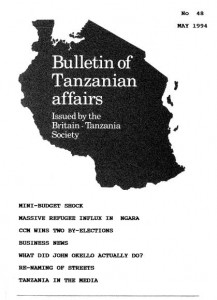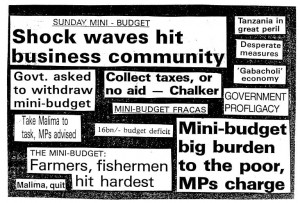ADJUSTMENT IN AFRICA. LESSONS FROM COUNTRY CASE STUDIES. Eds: Ishrat Husain and R Faruqee. World Bank. 1994. 436 pages.
It is difficult not to feel sympathy with Tanzania on the sheer amount of economic experimentation the country has been subjected to since independence. This second World Bank volume on structural adjustment (the first was reviewed in Bulletin No 48) in its Chapter 8 – ‘Tanzania – Resolute Action’, although some might question the appropriateness of the title, is comprehensive in outlining the economic history of Tanzania during the last thirty years. First there was the socialist period when left-leaning academics from around the world came to Tanzania to add their ideas to Julius Nyerere’s determined efforts to create a model socialist state. Then there are the last ten years when advocates of ‘structural adjustment’ tried out their ideas and learnt a lot of lessons.
The socialist period and the lessons to be learnt from its economic failure have been thoroughly thrashed out in many earlier issues of the Bulletin and are described succinctly in this book.
When the book goes on about the ‘economic recovery’ and ‘structural adjustment’ period there is much more detail. The authors write about the tentative steps taken from 1982 to 1985 – ‘but the background, orientation, hardened attitudes and ingrained habits of those entrusted with implementing the reforms clearly meant that the reform process would be difficult and slow8. And that is how it has been. The World Bank persisted in its efforts to persuade an often reluctant government to push ahead with more radical structural adjustment policies. Many would say, after the economic collapse of the early eighties, that there was no alternative.
Now, eight years later, we have two kinds of verdict. A group of increasingly militant NGO’s are launching an international campaign against World Bank structural adjustment policies. Early indications are that this opposition will need to marshal its facts and figures better than it has done so far, if it is to be successful. This book might be used as a model of the way in which it might be done. The Bank claims only modest success in Tanzania. Ghana is the success story. Tanzania is praised for rapidly turning round its economic performance and moving towards a more liberal, market-based economy. The evidence that this process was, in part at least, experimental, comes from the very extensive list of lessons which the Bank has learnt from what happened. The book reiterates that ‘greater attention should have been paid to …..’ ‘the reform programme should have been more strongly focused on. …..’ and so on. Table 8A summarises the picture in nine sections including fiscal policy, financial sector reforms, exchange rate management, wage policy reform, social sector policies and, in each case, compares the original situation with an assessment of the progress made in reform.
The book is essential reading for all interested in Tanzania’s economic affairs – DRB
THE NEW LOCAL LEVEL POLITICS IN EAST AFRICA. RESEARCH REPORT NO. 95. Ed: Peter Gibbon. Nordiska Afrikainstitutet Uppsala, Sweden. 1994. 119 pages.
The Tanzanian third of this book (it also covers Kenya and Uganda) written by Andrew S Z Kiondo, contains insights into a relatively new phenomenon in Tanzania – the rapid growth of formally organised community development activity (CDA) and non-governmental organisations (NGO’s). In 1993 there were 224 NGO1s registered compared with only 163 in 1990 – roughly two thirds of the latter had been formed since 1980.
During the era leading up to independence there had been a brief flourishing of independent trade unions, parents’ associations and youth organisations but, as the author puts it, ‘Independence saw a suppression of voluntary organisations and activities of all kinds as the state systematically penetrated/dissolved civil society and remoulded it in the image of the state itself1. The author goes on to describe the delicate relations now existing between local NGO’s – varying from the self-reliant to the ‘GONGO1s’ (Government organised) to those which are foreign supported – and the government. Taking into account recent political changes and the rise in racial and religious tensions, the author points out the lack of information on NGO1s and CDA1s. He tries to remedy this, in the most revealing part of the paper by a detailed study in a number of districts of Tanzania. For example:
– Ilala, Dar es Salaam – Muslim education/private health provision/religious based NGO1s/ Women CDA’s…. .
– Hai – day-care centres/religious and foreign NGO1s/the Hai Education Trust Fund/animal production NGO’s… .
– Pemba South – upsurge of economic CDA groups/an NGO run by OAU Secretary General Salim Ahmed Salim. ….
The author concludes by indicating how the Hai trust funds have all but displaced the local state and wonders whether this means privatisation of local government; he discusses in some depth the extent to which these new organisations are accountable – DRB
PEASANT SUPPLY RESPONSE AND MACROECONOMIC POLICIES: COTTON IN TANZANIA. Stefan Dercon. Journal of African Economies. Vol. 2 No. 2 October 1993. 38 pages.
Cotton is the second most important export crop in Tanzania (after coffee). It is mainly grown in the West – Mwanza and Shinyanga regions in particular. Production increased from about 25,000 tonnes of raw cotton in 1950 to a peak of 243 tonnes in 1966/67. It reached a low of 108,000 tonnes in 1985/86, the lowest level since 1961.
The main purpose of this article is to provide empirical evidence of the importance of various government policies on cotton production since the 1950,s. It undertakes an econometric analysis of the cotton supply function which includes such variables as cotton pricing, marketing policies, exchange rates, export taxation policies, prices for competing crops (maize and rice), inflation, taxation and availability indexes. The reasons why certain agricultural variables (such as input prices for seed or fertilizers) and climatic variables (such as rainfall) are excluded from the analysis are explained.
The main conclusions reached by the author are:
(1) That cotton producer prices have been adversely affected by government policies towards marketing, export taxation and the exchange rate. These prices have in turn affected cotton production through a significant supply response. The response to prices is a relative one: the relative cotton and food prices are the relevant variables; this implies that all increases in cotton production as a result of price changes will be at the cost of food production.
(2) Pricing policy resulted in a reduction in cotton production in the 1070’s and early 1980’s.
(3) The macroeconomic breakdown in Tanzania in the early 1980’s also had important consequences for cotton production. The effect of rationing was a large reduction of production and consequently of foreign exchange earnings from cotton.
(4) There was a striking difference of experience between the 1960’s and the 1970’s and 1980’s with a large trend increase in production stopping around the end of the 1960’s. These production increases were mainly caused by large yield increases, suggesting changes in technology used. This would suggest that the change in the policy environment after the Arusha Declaration in 1967 (including discouragement of cash crop production and villagisation) may well have had other effects than those working through pricing policy, but these were just as (if not even more) costly for peasant crop production and export earnings.
This is an interesting paper and the author has obviously put in a lot of work on the analysis and interpretation of results. I can’t however get over the impression that this was essentially a ‘desk study’ and that the author has little experience of either cotton or Tanzania.
There is not a mention of ginneries; the pivotal role they play in the cotton industry and how their nationalisation was disruptive. And I cannot agree with the statement that ‘while cotton cultivation was probably not forced upon farmers, extension officers often received premiums when large amounts of cotton were produced, therefore putting pressure on individual farmers’ (Page 167).
But my main bone of contention with this paper is that I don’t know how anyone can adequately write ‘Explaining Cotton Production in Western Tanzania’ (pages 165-69) over the years without reference to the multi-disciplinary research work carried out from 1934 to 1974 at the Ukiriguru Research Station, near Mwanza, by the Empire Cotton Growing Corporation (later the Cotton Growing Corporation). The Corporation was responsible in the 1940’s for the release of jassid resistant varieties without which cotton would never have become a major crop in Tanzania. The subsequent inclusion of bacterial blight and Fusarim wilt resistance added to the prosperity of the cotton industry. The continuous issue of new varieties from Ukiriguru, together with improved farming practices, is without doubt the underlying reason for yield increases up to the 1970’s.
A K Auckland
OTHER PUBLICATIONS
THE CONTINUING TRIAL OF DEVELOPMENT ECONOMICS: POLICIES, PRICES AND OUTPUT IN TANZANIAN AGRICULTURE. Jan Kees van Donge. Journal of International Development. Vol. 6, No 2.
1994. 27 pages. This article sets out, through a review of literature and with the help of an analysis of output patterns in Tanzanian agriculture, to challenge traditional views on the influence of national economic and political factors on agricultural production. The effects of government intervention are said to be much more ambiguous than usually assumed and many ‘erratic ‘ patterns are quoted. Does the author give enough importance to climate in causing such patterns? Stress is placed on regional differences and especially on social changes – migration, labour shortage, the changing status of women, the struggle between the old and the young or, as the author puts it, the shift from government policy to the politics of the household.
CEREAL MARKETING LIBERALIZATION IN TANZANIA. Jonathan Coulter and Peter Golob. Food Policy. Dec. 1992. 10 pages. This paper points out the success which has attended Tanzania’s cereal market liberalization.
TRADING RESPONSES TO FOOD MARKET LIBERALIZATION IN TANZANIA. Anita Santorum and Anna Tibaijuka. Food Policy. Dec. 1992. 11 pages. This paper examines market places and storage, credit and transport costs.
HYDROPOWER IN TANZANIA. K Dodman. International Power Generation. Jan. 1994. 3 pages. Tanzania has an installed electric generating capacity of 410 Megawatts of which 330 MW is hydropower. This informative short article brings us up to date on the £125 million 66 MW hydropower plant at Pangani Falls which is scheduled for completion in January 1995. Four of the five hydropower plants constructed there in 1934 are still operating (providing 15 MW) and further upstream there are plants at Hale (21 MW), Nyumba ya Mungu (8 MW) and Kikuletwa (1.2 MW). The article also explains the importance of water management to avoid the situation in 1992 when the reservoirs were so low that load shedding of up to 130 MW had to be imposed.
THE COST OF DIFFERENTIAL GENDER ROLES IN AFRICAN AGRICULTURE: A CASE STUDY OF SMALLHOLDER BANANA-COFFEE FARMS IN THE KAGERA REGION, TANZANIA. Anna Tibaijuka. Journal of Agricultural Economics Vol. 45 No 1. 1994. 12 pages. In 1982/83, due either to economic pressure or profit motivation, 30% of the men in a random sample of 200 smallholder banana coffee farms in the Kagera Region had adopted a more liberalised division of labour, and engaged in operations and horticultural farm enterprises that traditionally are the responsibility of women. Using a linear programming model, the author states that, by liberalising sex roles, cash incomes could increase by up to 10% while the productivity of labour and capital would improve by 15% and 44% respectively. The author measured 56 activities in crop production, 4 in animal production, 5 in farm processing, 9 intermediate activities like seed production, 20 consumption activities, 18 selling activities and 22 buying activities.
TANZANIA’S GROWTH CENTRE POLICY AND INDUSTRIAL DEVELOPMENT. M B K Dar Koh. Pub: Peter Lang, Frankfurt. 1944 Price: 89 DM. In 1979 a Growth Centre Strategy was initiated by government aimed at limiting the industrial growth of Dar es Salaam and spreading development to other regions. This book analyses the lessons to be learnt from the failure of the policy.
LIBERALIZATION AND PRIVATIZATION IN TANZANIA AND ZAMBIA. J M Due. World Development Vol. 21 No 12. 1993. 7 pages. This paper reviews early experience with, the short-run effects of and the way in which these governments are initiating post structural adjustment policies being advocated by the World Bank, IMF and donors.
CLEANER PRODUCTION IN TANZANIA. M Yhdego. UNEP Industry and Environment. Vol. 16 No 3. Sept. 1993. 2 pages. The author calls for legislation to bring about waste prevention and cleaner production instead of the more common ‘end-of-pipe1 pollution controls in Tanzanian industry. He gives the example of a study of a textile factory which recommended the installation of automatic shut-off valves on hoses, optimising rinse water usage, substituting certain chemicals and increasing the fixation rate of textile dyes.
ESTIMATING WOODY BIOMASS IN SUB-SAHARAN AFRICA. A C Millington and three others. World Bank 1994. 191 pages. This volume describes itself as a first attempt to map the vegetation and assess the stock and sustainable yield of wood resources. A 12-page section on East Africa describes the main land cover classes and the summary table on Tanzania estimates that the country has a sustainable yield of 111.7 million tons per year.
AFRICA: GROWTH RENEWED, HOPE REKINDLED. A Report on the Performance of the Development Fund for Africa 1988-92. USAID. 1994. 68 pages. This uncritical evaluation report has little to say on Tanzania but what it does say is significant. Writing about the US$ 40 million Agricultural Transport Assistance Programme (ATAP) it reports on a dramatic shift from using ‘moribund government capacity to reliance on private contractors’ – the increase was from nil in 1998 to 80% in 1992 of contractors engaged in road rehabilitation in the ATAP regions. There had been in Shinyanga a decline in vehicle operating costs of 37% and a decline in passenger fares of 18%
USING SITUATION ANALYSIS DATA TO ASSESS THE FUNCTIONING OF FAMILY PLANNING CLINICS IN NIGERIA, TANZANIA AND ZIMBABWE. Barbara Mensch and others. Studies in Family Planning Vol. 25 No 1. January/February 1994. 13 pages.
THE FISCAL IMPACT OF TRADE REFORMS IN TANZANIA IN THE 1980rS. W Lyakurwa. World Economy Vol. 16. No. 5. September 1993. 17 pages
PORTFOLIO MODELS AND PLANNING FOR EXPORT DIVERSIFICATION: MALAWI, TANZANIA AND ZIMBABWE. J Alwang and P B Siegel. Journal of Development Studies Vol. 30 (2). 1944. 17 pages.



